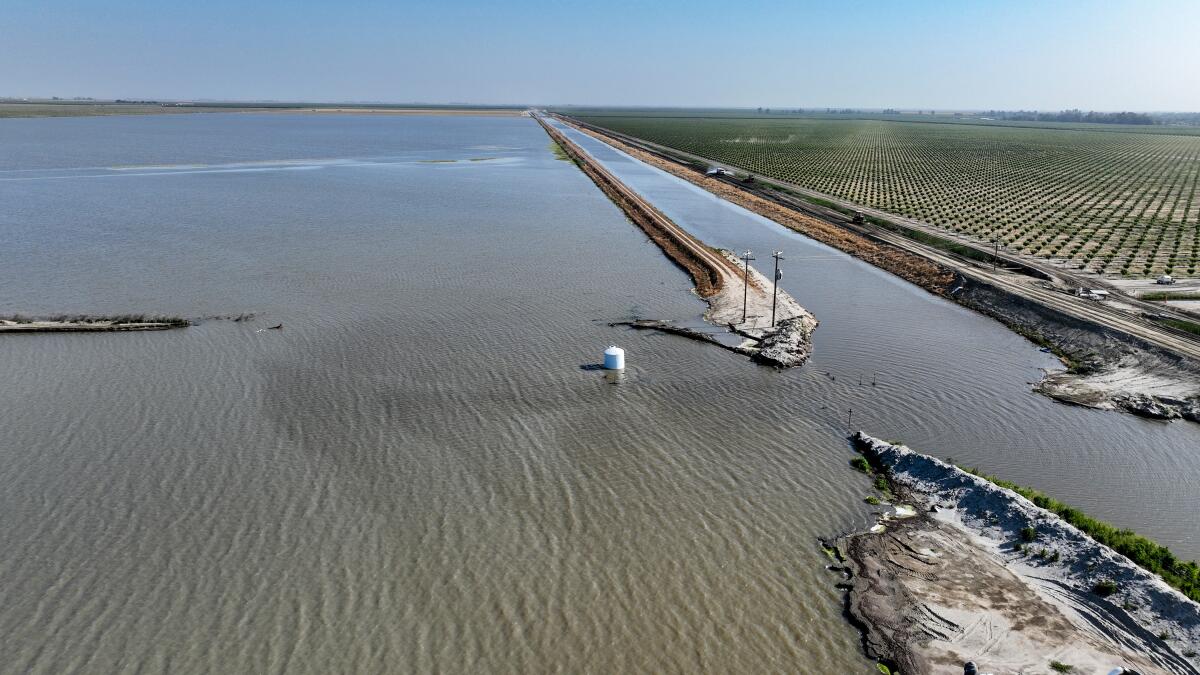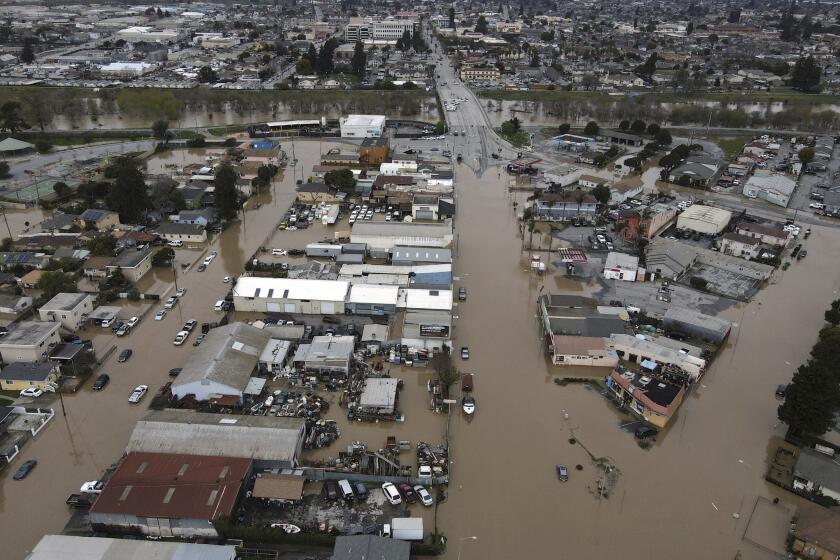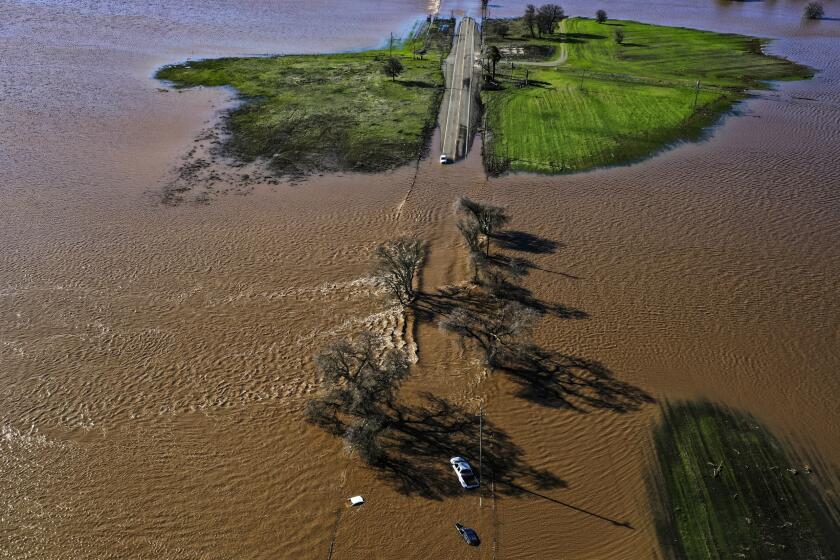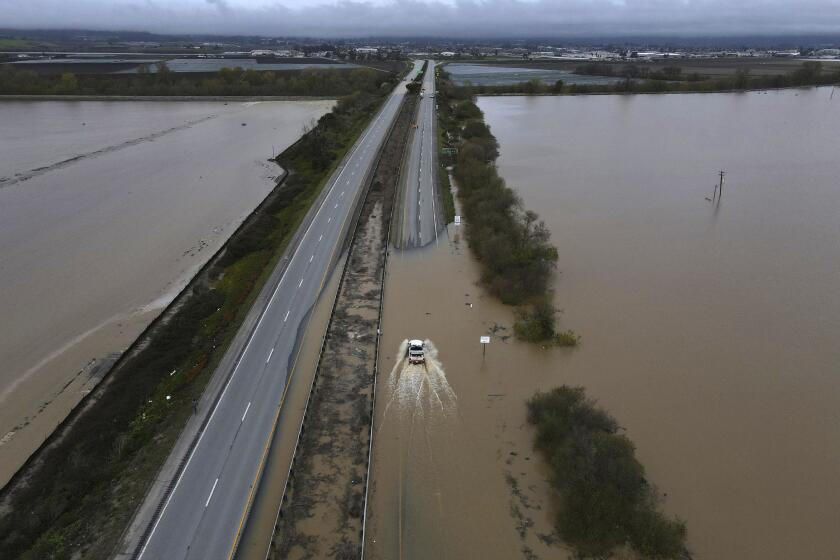California, facing another wet winter, races to prevent more flooding with levee repairs

- Share via
As forecasters sound the alarm about another potentially wet California winter fueled by El Niño, Gov. Gavin Newsom is taking urgent but controversial measures to prevent a repeat of the devastating floods that befell the state this year.
An executive order signed by the governor this month will streamline levee repairs and debris removal to help protect and prepare communities for another inundation. Last winter, dozens of levee breaches around the state sent stormwater rushing into communities — killing several people and causing considerable damage.
Restoring levees, river channels and other elements of the state’s aged flood infrastructure is crucial to public safety. But critics say Newsom’s order also comes at the expense of several rules and regulations designed to protect the environment.
“Managing California water by executive order is bad business,” said Barbara Barrigan-Parrilla, executive director of Restore the Delta. “Whether it’s drought or flood, we have to set proper science-based environmental standards and regulate according to those standards for the protection of people.”
The Pajaro River levee failure points to hazards that California has yet to address in many areas where communities are vulnerable, experts say.
Among the items outlined in the executive order are emergency repairs to levees directly affected by this year’s floods, including portions of the Tulare Lake Basin and areas along the Pajaro and San Joaquin rivers.
Such work is needed. In March, water spilled from canals and broken levees into farm fields in Tulare County, spurring the rebirth of the long-dry Tulare Lake and leaving thousands of acres under feet of water, which officials say could take years to dissipate.
Only weeks earlier, the swollen Pajaro River burst through its worn-down levee, flooding the entire town of Pajaro and sending its roughly 3,000 residents into a months-long exile from their homes.
Officials in Pajaro said the executive order was long in the making, as politicians in flood-prone regions have been urging the governor to make it easier to protect their communities.
“The governor made clear after the storms that he would do whatever was necessary to help expedite efforts along the levee and basin, and this was our key ask,” said Zach Friend, Santa Cruz County supervisor and a member of the Pajaro Regional Flood Management Agency Board.
The levee that was breached in March had been slated for an upgrade and new construction when the flooding happened, but the work had not yet begun. With a new threat of storms later this year, he said that every burden removed to make the project a reality “has the potential to save lives and livelihoods in the Pajaro Valley.”
Thousands of miles of California levees are feeling the strain of age, extreme drought and punishing atmospheric rivers.
But the order will also suspend a number of environmental laws, regulations and criteria — including elements of the California Environmental Quality Act — to fast-track the work.
Among the suspended items are laws and regulations that guide alterations to lakes and streambeds. Certain water quality rules and permitting procedures were also waived to help expedite clearing and maintenance of flood control channels.
Barrigan-Parrilla said such decisions reflect a lack of long-term flood planning and emergency preparations.
“Environmental regulations are always the first to go, rather than doing the hard, long-term work of building water sustainability and flood management plans,” she said.
Deirdre Des Jardins, an independent water researcher and advocate, said similarly the emergency order doesn’t address the larger issue: that California’s flood control infrastructure suffers from inadequate maintenance and funding.
She called the order “a Band-Aid on just a huge, huge issue of long-term inadequate maintenance of flood control channels.”
Des Jardins has been calling for significantly more funding to prepare California for severe flood risks, saying state and federal investments are failing to keep up with intensifying risks due to climate change.
“It is going to be expensive to deal with. And the state needs more of a plan. This is not a plan. This is just scrambling,” Des Jardins said.
For years, experts had been warning Monterey and Santa Cruz County that the levee along the Pajaro River could fail.
However, some experts said the fast-tracked rules could make sense when applied judiciously. The onset of the state’s wet season is only months away, and future storms could bring considerable flood risk.
“The high-flood-risk areas that were so dramatically exposed during this last rain and snow season, those are areas where those projects have just got to get done, and they’ve got to get done quickly,” said Mark Gold, director of water scarcity solutions at the Natural Resources Defense Council. “As we saw, low-income communities were disproportionately impacted in such a major way, and we just can’t let that happen.”
Gold also voiced concerns about some of the strategies outlined in the order, including an item that allows for as much as 30% of native vegetation to be removed from stream channels. The rule doesn’t include any recommendations or requirements for how the removed material should be disposed of, meaning it could end up in a landfill, he said.
“We have a state that’s doubling down on nature-based solutions, we’re seeing vulnerability with sea level rise that’s hugely concerning ... and yet, there’s not a sentence in here on beneficial reuse of the sediment that’s removed,” Gold said.
What’s more, the order defers many permitting decisions to the federal Army Corps of Engineers, which helps manage many of the state’s dams, reservoirs and other water infrastructure.
“The feds’ review of these types of projects is generally a lot less rigorous than the state,” Gold said. “And so that’s why this matters.”
There is an 84% chance the system will be of moderate strength, and a 56% chance it will become a strong event at its peak, forecasters said.
Much of the executive order is predicated on the arrival of a second wet winter, which looks likely but is not guaranteed.
El Niño, the climate pattern in the tropical Pacific, arrived earlier this summer and is expected to gain strength as the year progresses. El Niño is associated with hotter global temperatures and wetter conditions in the state, particularly Southern California.
Long-term precipitation outlooks from the National Oceanic and Atmospheric Administration are inconclusive about what to expect in most of the country. However, the agency says there is a 90% chance that El Niño will persist through the winter.
There is reason to expect wetter conditions from the system. The El Niño winter of 1997-98 brought powerful precipitation to California, including a series of storms that ended with 17 deaths and more than half a billion dollars of damage in the state.
The 1982-83 El Niño was linked to near-record-setting precipitation in the northern Sierra and one of the state’s costliest flood seasons in decades, which saw decimated piers and thousands of damaged homes.
But in 2015-16, a strong El Niño failed to deliver significant rain, flooding and other anticipated effects in Southern California, ultimately dropping only about 6 inches of rain.
Newsom’s order follows other actions taken in response to this year’s flooding. In May, the governor allocated $17.2 million to help fortify the Corcoran levee, a critical piece of flood control infrastructure that protects the city of Corcoran — and its sprawling prison complex — from the flooded Tulare Lake.
He also signed executive orders in February and March that allowed the state to reroute hundreds of thousands of acre-feet of water from the storms into areas where it could percolate into the ground and replenish aquifers drained by years of drought.
That move also stoked the ire of some environmental groups, which said the diversions allowed for lower flows in the San Joaquin River and would probably be harmful for Chinook salmon, among other concerns.
More to Read
Sign up for Essential California
The most important California stories and recommendations in your inbox every morning.
You may occasionally receive promotional content from the Los Angeles Times.

















